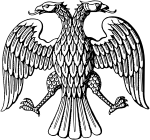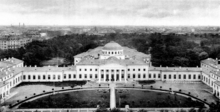
Back الجمعية التأسيسية الروسية Arabic Asamblea Constituyente Rusa AST Ümum-Rusiya Müəssislər Məclisi Azerbaijani Бөтә Рәсәй Ойоштороу йыйылышы Bashkir Усерасейскі ўстаноўчы сход BE-X-OLD Ruské ústavodárné shromáždění Czech Пĕтĕм Раççей Йĕркелĕм Пухăвĕ CV Russische konstituierende Versammlung German Ρωσική Συντακτική Συνέλευση Greek Rusia Konstitucifara Asembleo Esperanto
All-Russian Constituent Assembly Всероссийское Учредительное собрание | |
|---|---|
 The double-headed eagle, which remained the de jure coat of arms of Russia until 10 July 1918. Never formally used prior to the dissolution of the Assembly. | |
| Type | |
| Type | |
| History | |
| Established | 1917 |
| Disbanded | 1918 |
| Preceded by | Council of the Russian Republic |
| Succeeded by | VTsIK All-Russian Congress of Soviets Provisional All-Russian Government Both VTsIK and Congress had also governed Russia since the October Revolution |
| Leadership | |
Chairman of the Constituent Assembly | |
| Structure | |
| Seats | 767 |
 | |
Political groups | Bolsheviks: 183 seats Mensheviks: 18 seats Armenian Revolutionary Federation: 10 seats Socialist Revolutionary Party: 324 seats Ukrainian Socialist-Revolutionary Party: 110 seats Kadets: 16 seats Alash Orda: 15 seats Musavat Party: 10 seats Cossacks: 17 seats Others: 64 seats |
| Elections | |
| Direct multi-party elections via the proportional representation system (D'Hondt method was used to allocate seats in 81 multi-member districts) | |
Last election | 25 November 1917 |
| Meeting place | |
 | |
| Tauride Palace | |
The All Russian Constituent Assembly[a] (Russian: Всероссийское учредительное собрание, romanized: Vserossiyskoye uchreditelnoye sobraniye) was a constituent assembly convened in Russia after the February Revolution of 1917. It met for 13 hours, from 4 p.m. to 5 a.m., 18–19 January [O.S. 5–6 January] 1918, whereupon it was dissolved by the Bolshevik-led All-Russian Central Executive Committee,[2][3][4][5] proclaiming the Third All-Russian Congress of Soviets the new governing body of Russia.[6][7][8]
The 1917 Russian Constituent Assembly election did not produce a democratically elected government, as the Bolsheviks, who were in power since the October Revolution which occurred prior to the election, subsequently disbanded the Constituent Assembly and proceeded to rule the country as a one-party state with all opposition parties outlawed.[9][2][3][4][5][6][7][8] Some scholars have had a differing view and attributed the establishment of the one-party system in the Soviet Union to the wartime conditions imposed on the Bolshevik government[10] and others have highlighted the initial attempts to form a coalition government with the Left Socialist Revolutionaries.[11]
- ^ (Russian) Всероссийское Учредительное собрание в документах и материалах[dead link]
- ^ a b The Bolsheviks: the intellectual and political history of the triumph of communism in Russia : with a new preface. Adam Bruno Ulam. Harvard University Press. p. 397.
- ^ a b The Rise and Fall of the Soviet Union. Richard Sakwa. p. 73
- ^ a b Russia in War and Revolution: General William V. Judson's Accounts from Petrograd, 1917-1918. William Voorhees Judson. Kent State University Press. p. 229
- ^ a b How the Soviet Union is Governed. Jerry F. Hough. p. 80
- ^ a b Russia in the Twentieth Century: The Quest for Stability. David R. Marples. p. 38
- ^ a b How the Soviet Union is Governed. Jerry F. Hough. p. 81
- ^ a b The Life and Times of Soviet Socialism. Alex F. Dowlah, John E. Elliott. p. 18
- ^ Концепция социалистической демократии: опыт реализации в СССР и современные перспективы в СНГ
- ^ Rogovin, Vadim Zakharovich (2021). Was There an Alternative? Trotskyism: a Look Back Through the Years. Mehring Books. pp. 13–14. ISBN 978-1-893638-97-6.
- ^ Carr, Edward Hallett (1977). The Bolshevik revolution 1917 - 1923. Vol. 1 (Reprinted ed.). Penguin books. pp. 111–112. ISBN 978-0-14-020749-1.
Cite error: There are <ref group=lower-alpha> tags or {{efn}} templates on this page, but the references will not show without a {{reflist|group=lower-alpha}} template or {{notelist}} template (see the help page).